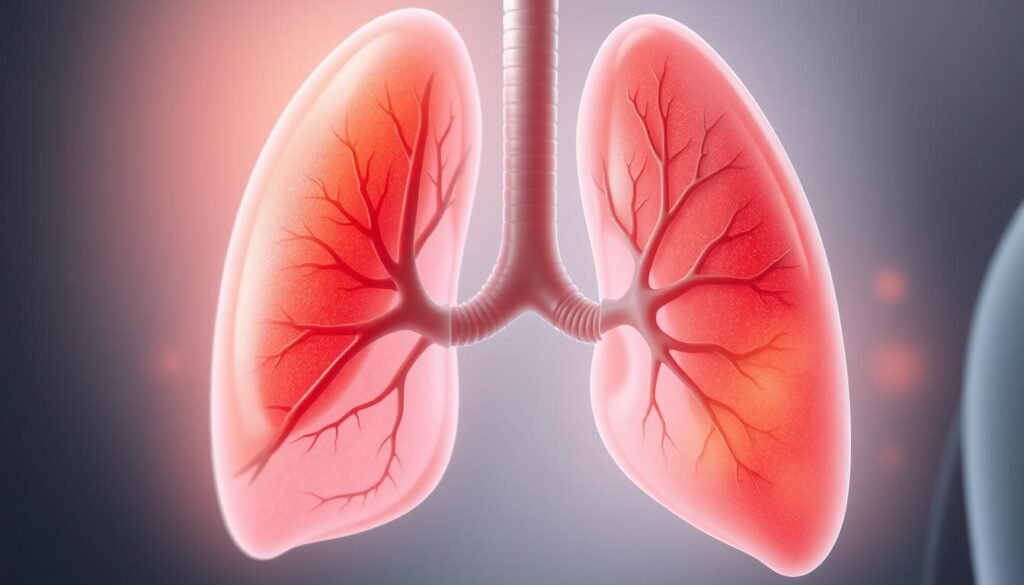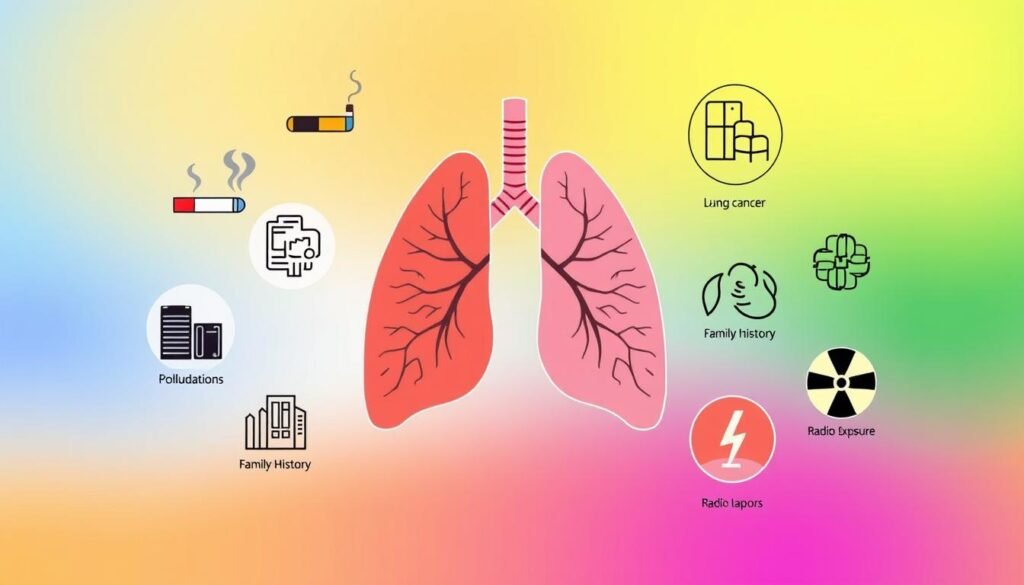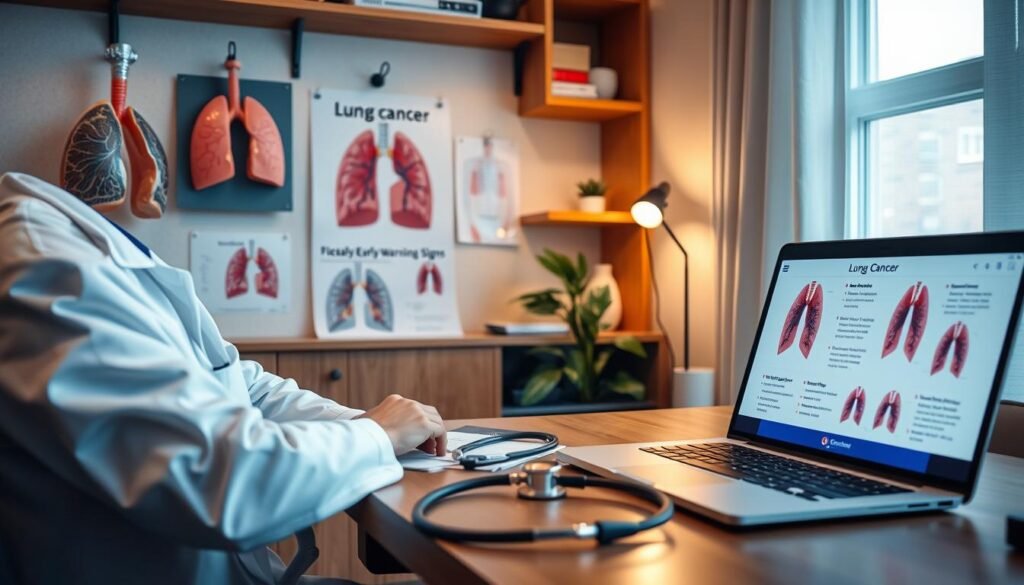Did you know about 80% of people with finger clubbing might have lung cancer? This fact shows how important it is to watch out for early signs of lung cancer. Since many cases are not found until they are advanced, spotting early signs can help a lot.
Symptoms like a non-stop cough, losing weight without trying, and feeling discomfort in the chest are signs. These should not be overlooked because they might be signs of something serious. It’s very important to increase lung cancer awareness. This encourages people to get checked by a doctor, even if the symptoms seem small or like they’re from another condition.
Key Takeaways
- Recognizing early lung cancer symptoms can lead to earlier diagnosis.
- Persistent coughing and unexplained weight loss are critical warning signs.
- Many individuals may overlook symptoms, mistaking them for less severe conditions.
- Lung cancer awareness can improve treatment outcomes through early detection.
- Seeking medical attention when experiencing unusual symptoms is vital for health.
Understanding Lung Cancer
Lung cancer starts when cells in the lung grow out of control. This can form tumors. There are two main kinds: non-small cell lung cancer (NSCLC) and small cell lung cancer (SCLC). NSCLC makes up about 85% of cases and grows more slowly.
SCLC is about 15% of cases and grows fast. This lung cancer overview shows why knowing the difference matters. It helps choose the best treatment.
- Surgery: Good for NSCLC that hasn’t spread and some SCLC cases. It might involve taking out part or the whole lung.
- Radiofrequency Ablation: A less invasive way to attack edge tumors. It uses heat to kill the cancer cells.
- Radiation Therapy: Uses strong beams to kill cancer cells. Can be alone or with surgery.
- Chemotherapy: Given through IV, often uses many drugs to stop cancer cell growth.
- Targeted Drug Therapy: For NSCLC with certain mutations. This therapy tries to slow or kill the bad cells.
- Immunotherapy: Boosts the immune system to fight cancer cells better.
Treating lung cancer aims at the disease but also helps with symptoms. These might include pain and trouble breathing. Side effects from treatment vary a lot. They can cause nausea, vomiting, hair loss, and tiredness. Managing side effects usually means medicines and help from care specialists. This ensures patients live as well as they can while fighting cancer.
What Are the Early Stages of Lung Cancer?
Early stages of lung cancer may not be easy to spot. This is because these stages often don’t have clear signs. Spotting signs early, like a long-lasting cough or feeling out of breath, is key for quick check-ups.
Knowing how lung cancer grows is very important. This knowledge helps in choosing the best treatment and can improve results.
Staging of lung cancer shows how much the disease has grown. For the most common type, Non-small cell lung cancer (NSCLC), stages range from 0 to IV. Stages 0 and I mean the cancer might not have spread much. Here are some details:
| Stage | Description |
|---|---|
| Stage 0 | Early-stage cancer, confined to the top lining of the lung or bronchus. |
| Stage I | No spread to lymph nodes or other parts of the body; tumor size is typically 4 centimeters or less. |
| Stage II | Tumors may be larger with some involvement of nearby lymph nodes. |
| Stage III | More extensive spread, often involving mediastinal lymph nodes. |
| Stage IV | The most advanced stage with metastasis to distant organs. |
People with early-stage NSCLC have better chances of survival. Treatments, like surgery to remove a lung’s part, are common. Early detection is super important for a good outcome. By paying attention and getting help early, people can really make a difference in their treatment success.
Common Lung Cancer Symptoms
Knowing about lung cancer symptoms helps with early detection and treatment. It’s important to watch for any strange signs. Early signs of lung cancer slowly appear. Recognizing them early is key for prompt treatment.
Persistent Coughing
A cough that doesn’t go away can signal lung cancer. It’s concerning if it gets worse or changes. If there’s a cough for no clear reason, one should be wary.
Chest Pain and Discomfort
Chest pain that gets sharper when breathing deeply, coughing, or laughing is an important sign. Such symptoms are serious and could mean lung complications that need quick action.
Shortness of Breath
Shortness of breath may be caused by tumors or fluid in the lungs. This difficulty breathing is concerning and needs checking to exclude lung cancer.
Unexplained Weight Loss
Losing weight without trying is concerning. It may show metabolism changes or problems linked to lung cancer and needs checking.
| Symptom | Description |
|---|---|
| Persistent Coughing | A chronic cough that does not go away and may worsen over time. |
| Chest Pain and Discomfort | Pain that increases when breathing deeply, coughing, or laughing. |
| Shortness of Breath | A feeling of being winded or difficulty in breathing, often worsening with activity. |
| Unexplained Weight Loss | Significant weight loss without intentional dieting or exercise. |
Noticing these lung cancer symptoms is the first step toward health evaluation. Catching cancer early is crucial for better treatment outcomes.
Early Stages of Lung Cancer: Know the Warning Signs
Lung cancer is the second most common cancer in the United States. Knowing early warning signs is key to raising awareness. Early detection can greatly improve a patient’s chances of survival.
A chronic cough that lasts more than eight weeks is a major symptom. It may get worse and could come with hemoptysis. This means coughing up blood or bloody mucus. These signs should not be ignored and need quick medical attention.
Shortness of breath might also occur, due to tumors blocking airways. This can make everyday activities hard. Chest pain, especially with deep breaths or coughs, is another serious sign.
Frequent lung infections like bronchitis and pneumonia can happen with lung cancer. This is because tumors can block airways. A hoarse voice can also be a sign if a tumor affects vocal cords or constant coughing.

Those at high risk for lung cancer include heavy and current smokers. This also includes people who’ve quit in the past 15 years, and those aged 55 to 80. Screenings are crucial for these individuals. Early detection can lead to more effective treatment and better survival rates.
| Warning Signs | Description |
|---|---|
| Chronic Cough | A lasting cough persisting for more than eight weeks. |
| Hemoptysis | Coughing up blood or bloody mucus. |
| Shortness of Breath | Difficulty breathing due to narrowed airways. |
| Chest Pain | Pain while breathing deeply, coughing, or laughing. |
| Recurring Respiratory Infections | Frequent bronchitis or pneumonia due to airway obstruction. |
| Hoarseness | Change in voice quality often related to vocal cord involvement. |
Being vigilant about these warning signs is vital. Knowing them helps people seek the medical care they need early. This is a big part of staying on top of your health.
Specific Symptoms of Non-Small Cell Lung Cancer
Non-small cell lung cancer (NSCLC) shows different symptoms that are key in finding it early. Knowing these signs can lead to quick treatment, which is very important for success. Here are some symptoms of NSCLC to watch out for.
Fatigue and Weakness
Feeling very tired can be the first clue of lung cancer. This kind of tiredness makes even small tasks hard to do. If you’re feeling tired all the time, it’s a good idea to see a doctor.
Wheezing and Hoarseness
Changes in your voice or strange breathing sounds could be signs of NSCLC. These signs might mean the cancer is blocking airways or affecting nearby areas. It’s important to get these symptoms checked right away to understand what’s happening.
Coughing Up Blood or Rust-Colored Sputum
Finding blood or rust-colored mucus is serious and needs attention. It could mean the cancer has spread to the airways. Spotting these signs early is key for tests and starting treatment. For more details on NSCLC symptoms, check out this study.
| Symptom | Description |
|---|---|
| Fatigue | Constant tiredness that affects everyday life. |
| Wheezing | Unusual breathing sounds that might suggest airway problems. |
| Coughing Up Blood | Seeing blood in spit; a warning sign of cancer in the airways. |
Understanding the Risk Factors for Lung Cancer
Knowing lung cancer risk factors is key to preventing it. Some habits and environmental factors greatly raise the chance of getting it. By understanding these, people can make better choices for their health.
Smoking and Secondhand Smoke Exposure
Smoking is the top cause of lung cancer, tied to about 90% of cases. Smokers have a 15 to 30 times higher risk of lung cancer than non-smokers. Being around smokers also increases the risk for non-smokers. This highlights the importance of efforts to quit smoking and reduce tobacco use.
Radon Exposure
Radon is a colorless gas coming from the soil, which can build up in buildings. It’s the second main cause of lung cancer in the U.S., responsible for many deaths in non-smokers. Smokers face even greater risks from radon. Testing homes for radon is critical for lowering these dangers.
Lung Nodules and Their Significance
Lung nodules, or small growths, may hint at lung cancer risk. Though many are harmless, some could indicate cancer or an increased risk of it. It’s vital to keep an eye on lung nodules for early cancer detection. For more info on lung cancer risks, visit here.

The Role of Lung Cancer Screening
Lung cancer screening is key to finding the disease early and treating it successfully. This is particularly true for people at high risk. These include smokers or those with a family history of lung cancer. Lung cancer is the world’s second most common cancer. It had about 2.2 million new instances in 2020 alone. Knowing how to screen for it correctly could save lives.
Importance of Early Detection
Finding lung cancer early greatly improves chances of beating it. The five-year survival rate is over 75% when caught early. This is in stark contrast to less than 10% at stage IV. These facts highlight how crucial early screening is. It helps catch the cancer before it gets worse.
Methods for Lung Cancer Screening
Now, the main way to screen for lung cancer is with low-dose computed tomography (LDCT) scans. These are better than the old chest X-rays at finding early lung cancer. Groups like the National Comprehensive Cancer Network support LDCT for people at high risk who show no symptoms. Studies show that LDCT scans can lower the death rate from lung cancer by around 20%.
Chest X-Rays and CT Scans
Chest X-rays were once common for finding lung cancer. But they often miss early signs that LDCT can catch. LDCT has shown a 76% success rate in diagnosing lung cancer. That’s much higher than older methods. Health guidelines now suggest yearly screenings for folks between 50 to 80 who have smoked a lot. Knowing how chest X-rays differ from LDCT helps make better health choices.
Seeking Medical Attention
It is important to talk to a doctor about lung health. Knowing when to get a lung cancer check is key. Look out for signs like a bad cough, losing weight without trying, or always feeling out of breath. Catching these signs early is crucial. The American Cancer Society points out that symptoms often don’t show until the cancer is serious.
When to Consult a Doctor
It’s vital to take care of your lungs by seeing a doctor early. You should see a doctor if you have:
- A cough that lasts more than three weeks
- Unexpected weight loss
- Chest pain that gets worse
- Feeling short of breath when doing simple activities
- Spitting up blood
Noticing these symptoms means it’s time to take charge of your health. Talking openly with your doctor is the first step in dealing with lung cancer.
Preparing for Your Doctor’s Visit
Getting ready for your doctor’s visit can make it more helpful. Here’s what you can do:
- Make a list of your symptoms, including how bad and how long they’ve been happening
- Know your family’s health history to share with your doctor
- Be honest about your habits, like if you smoke, as it matters for your check-up
Collecting this info helps your doctor understand your situation better. This ensures a good check-up and advice on what to do next. It’s important to know about lung cancer screening, especially for those at high risk.

The Impact of Paraneoplastic Syndromes
Paraneoplastic syndromes are conditions caused by lung cancer that affect distant organs. These can appear even before the cancer spreads. They make diagnosing and treating the cancer more complex. It’s crucial to recognize these syndromes to manage lung cancer effectively.
Understanding Paraneoplastic Symptoms
About 1-7.4% of cancer patients face paraneoplastic syndromes. Small cell lung cancer (SCLC) is often linked with these conditions. Each year, 30,000 people get diagnosed with SCLC in the U.S. This accounts for 14% of all lung cancer cases. Nearly 90% of these patients are already at a metastatic stage when diagnosed. Spotting paraneoplastic syndromes early can help in treating them sooner.
- Syndrome of Inappropriate Antidiuretic Hormone (SIADH): This happens when a tumor makes too much antidiuretic hormone. It leads to water retention and electrolyte issues.
- Lambert-Eaton Myasthenic Syndrome (LEMS): About 60% of SCLC patients may develop this autoimmune disease. It weakens muscles.
These syndromes can cause hormonal imbalances. For example, Cushing syndrome can lead to fatigue, muscle loss, and big weight changes. SIADH can also cause too much fluid in the body and high blood pressure.
It’s tough to diagnose paraneoplastic syndromes because their symptoms are similar to cancer’s. But, finding specific antibodies in the blood or spinal fluid can help. Tests like CT scans and PET scans are also useful for finding the cancer.
Dealing with paraneoplastic syndromes can improve how we treat lung cancer. Treatments may include drugs like corticosteroids and immunosuppressants. These help manage the hormonal symptoms and complications from lung cancer.
Lung Cancer in Nonsmokers
Lung cancer isn’t only linked to smoking. Nonsmokers can get it too. Around 10% to 20% of lung cancers in the U.S. happen to those who’ve never smoked much. This shows the need to learn more about nonsmoking lung cancer. There are different symptoms and risk factors for nonsmokers.
Unique Symptoms and Risk Factors
Nonsmokers should know the special lung cancer symptoms they might face. Some signs include:
- Persistent cough
- Shortness of breath
- Chest pain
- Unexplained weight loss
Risk factors for nonsmokers include environmental and genetic issues. Important ones are:
| Risk Factor | Description |
|---|---|
| Secondhand Smoke Exposure | Being around smoker’s smoke greatly increases risk, causing 15–35% of cases. |
| Radon Exposure | Radon is colorless and odorless. It’s found in homes and causes about 2% of lung cancer deaths in Europe. |
| Air Pollution | Polluted air can also raise lung cancer risk in nonsmokers over time. |
| Family History | Some families have a higher chance due to genetics, often linked to EGFR mutations. |
| Asbestos and Other Chemicals | Chemicals like asbestos, arsenic, silica, and chromium increase the risk. |
About 62% of nonsmokers find out they have lung cancer at stage IV, while it’s 49% for smokers. Knowing the factors and symptoms is key to early detection and treatment. It helps improve the chances for those with nonsmoking lung cancer.
Conclusion
Knowing about lung cancer early on is key. Spotting warning signs like a constant cough or weight loss matters a lot. It’s crucial for people at high risk to know how to prevent lung cancer and the value of finding it early.
Regular check-ups with doctors help people get the right help fast. This leads to finding the disease early. Health awareness is really important. Catching lung cancer early means treatment works better. This can save lives.
Lung cancer causes many deaths, so knowing about it is a must. Knowing what to look out for helps a lot. For info on lung cancer signs, see early warning signs of lung cancer.
Taking control of your health by learning helps with catching lung cancer fast. Being early and informed makes a big difference. It also helps everyone talk better about lung cancer’s effects. For more on screening and risks, look at how genetics and the environment matter.